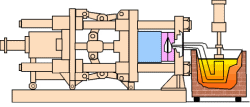
|

|
|
Home Privacy Sitemap |
| ||||||||||
|
Hot Chamber Zinc Die Casting ProcessIn the Hot Chamber Zinc Die Casting process, ingots of zinc are melted in a furnace at approximately 700-800 Degrees Fahrenheit. Once liquefied, the zinc metal remains in the furnace. The shot sleeve (called a gooseneck for its shape like a goose's neck) is immersed in the furnace (Hot Chamber) and the molten zinc metal is injected directly from the furnace into the two die halves held together by the machine. The two halves of the die casting die or die casting mold are mounted on the machine and the machine closed and holds the two die halves together. The molten zinc metal is then injected with hydraulic pressure into the two halves of the die. The molten zinc metal is then held under high pressure until the metal solidifies, usually within only a matter of 2-15 seconds depending on the size of the parts. The die halves are then opened and the part(s) ejected and removed by hand or robotically. Finishing operations follow such as trimming, tumble deburring, precision machining, painting, anodizing, chrome plating and assembly.

Hot Chamber Zinc Die Casting Machine Hot chamber die casting machines are used primarily for zinc, copper, magnesium, lead and other low melting point alloys that do not readily attack and erode metal furnace pots, cylinders and plungers. The injection mechanism of a hot chamber die casting machine is immersed in the molten metal bath of a metal holding furnace. The furnace is attached to the machine by a metal feed system called a gooseneck. As the injection cylinder plunger rises, a port in the injection cylinder opens, allowing hot molten metal to fill the cylinder. As the plunger moves downward it seals the port and forces molten hot metal through the gooseneck and nozzle into the die cavity. After the metal has solidified in the die cavity, the plunger is withdrawn, the die opens and the die casting is ejected. |
|||||||||||
|
sales@diecastingzinc.com |